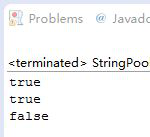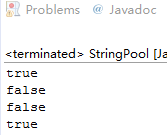04-String
动手动脑问题和课后实验性问题总结
一、请运行以下示例代码,查看其输出结果。如何解释这样的输出结果?从中你能总结出什么?
public class StringPool {
public static void main(String args[])
{
String s0="Hello";
String s1="Hello";
String s2="He"+"llo";
System.out.println(s0==s1);//true
System.out.println(s0==s2);//true
System.out.println(new String("Hello")==new String("Hello"));//false
}
}

原因分析:在java中,内容相同的字串常量(“Hello”)只保存一份以节约内存,所以s0,s1,s2实际上引用的是同一个对象。编译器在编译s2一句时,会去掉“+”号,直接把两个字串连接起来得一个字串(“Hello”)。这种优化工作由Java编译器自动完成。当直接使用new关键字创建字符串对象时,虽然值一致(都是“Hello”),但仍然是两个独立的对象。
二、为什么会有上述的输出结果?从中你又能总结出什么?
public class StringPool {
public static void main(String args[])
{
String s1="a";
String s2=s1;
System.out.println(s1==s2);
s1+="b";
System.out.println(s1==s2);
System.out.println(s1=="ab");
System.out.println(s1.equals("ab"));
}
}

原因分析:
给字串变量赋值意味着:两个变量(s1,s2)现在引用同一个字符串对象“a”!
String对象的内容是只读的,使用“+”修改s1变量的值,实际上是得到了一个新的字符串对象,其内容为“ab”,它与原先s1所引用的对象”a”无关,所以,s1==s2返回false;
代码中的“ab”字符串是一个常量,它所引用的字符串与s1所引用的“ab”对象无关。
String.equals()方法可以比较两个字符串的内容。
使用equals()或equalsIgnoreCase()方法比较两字串内容是否相同,使用==比较两字串变量是否引用同一字串对象。
三、请查看String.equals()方法的实现代码,注意学习其实现方法。
public boolean equals(Object anObject)
{
if(this == anObject)
{
return true;
}
if(anObject instanceof String)
{
String anotherString=(String) anObject;
int n=value.length;
if(n == anotherString.value.length)
{
char v1[]=value;
char v2[]=anotherString.value;
int i=0;
while(n-- != 0)
{
if(v1[i] != v2[i])
return false;
i++;
}
return true;
}
}
return false;
}
四、整理String类的Length()、charAt()、 getChars()、replace()、 toUpperCase()、 toLowerCase()、trim()、toCharArray()使用说明
length():
public int length();//求字符串长度
String s=”abcdefg”;
System.out.println(s.length());
charAt():
String s=new String(“abcdefg”);
//取字符串中的某一个字符。字符串的序数从0开始到length()-1.
System.out.println(“s.charAt(2):”+s.charAt(2));
getChars():
public int getChars();//将字符从此字符串复制到目标字符数组
String str=”abcdefghijk”;
Char[] ch=new char[8];
Str.gerChars(2,5,ch,0);
replace():
Public int replace();//替换字符串
String s=”abc”;
System.out.println(s.replace(“abc”,”def”));
toUpperCase():
Public String toUpperCase()//将字符串全部转换成大写格式
System.out.println(new String(“abcdef”).toUpperCase());
toLowerCase():
Public String toLowerCase()//将字符串全部转换成小写
System.out.println(new String(“ABCDEF”).toLowerCase());
trim():
Public String trim();//去掉两边的空格
String s=” a aa”;
System.out.println(s.trim());
toCharArray():
String x=” abcdefg”;//将字符串对象中的字符转换为一个字符数组
Char myChar[]=x.toCharArray();
System.out.println(“myChar[1]”+myChar[1]);
五、String类的方法可以连续调用:
String str="abc";
String result=str.trim().toUpperCase().concat("defg");
请阅读JDK中String类上述方法的源码,模仿其编程方式,编写一个MyCounter类,它的方法也支持上述的“级联”调用特性,其调用示例为:
MyCounter counter1=new MyCounter(1);
MyCounter counter2=counter1.increase(100).decrease(2).increase(3);
源程序代码:
public class MyCounter {
int data;
public MyCounter(int data)
{
this.data=data;
}
public MyCounter()
{
}
public MyCounter Increase(int d)
{
MyCounter m=new MyCounter();
m.data=data+d;
return m;
}
public MyCounter Decrease(int d)
{
MyCounter m=new MyCounter();
m.data=data-d;
return m;
}
public static void main(String[] args)
{
MyCounter counter1=new MyCounter(1);
MyCounter counter2=counter1.Increase(100).Decrease(2).Increase(3);
System.out.println(counter2.data);
}
}
